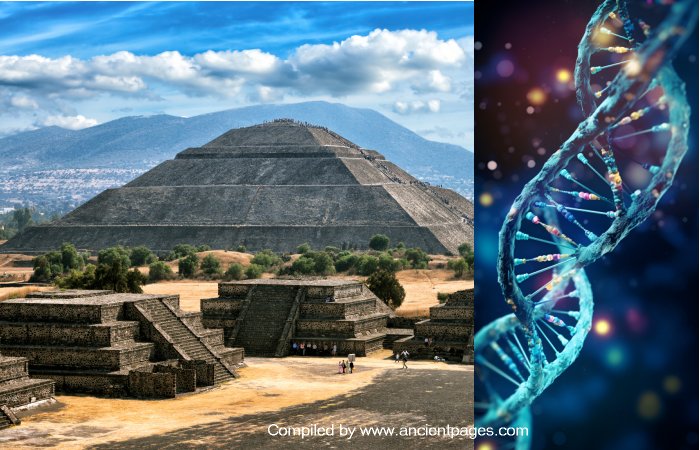Conny Waters – AncientPages.com – One of the most intriguing archaeological pre-Columbian sites is Teotihuacán, which scientists still know relatively little about. Who were the people who built and lived in Teotihuacán?
Established in the northeastern Basin of Mexico, Teotihuacán “was first inhabited in about 150 BC, but the first ceremonial buildings were constructed in the 1st and 2nd centuries AD. It is believed that Teotihuacán, most probably the largest city in the New World, had about 150,000 – 200,000 inhabitants at its height.” 1
Teotihuacan was once a very powerful Mesoamerican city. Credit: Adobe Stock – Dmitry Rukhlenko
Teotihuacan was one of the largest metropolitan centers in ancient Mesoamerica in the pre-Columbian era. The ancient city flourished the most in the fourth century AD, exerting a significant cultural influence throughout Mesoamerica.
In a new study, researchers led by Dr. Fuzuki Mizuno at the Toho University School of Medicine have examined six ancient individuals unearthed from the Teotihuacan between the third and seventh centuries AD.
Scientists have determined the entire mitochondrial DNA sequences of these ancient Teotihuacans, revealing their genetic diversity. Additionally, this study demonstrates the dependence of Teotihuacans on maize as their primary food source.
In studying ancient societies, DNA analysis of individuals excavated from archaeological sites has provided critical insights into the lives of those who lived there. However, the success of ancient DNA analysis is highly dependent on preserving the DNA samples. The Teotihuacan region is not favorable for preserving ancient DNA because of the climate, highly fluctuating temperature and humidity, and the properties of volcanic ash soil.
In the analysis of stable isotope ratios (δ13C and δ15N), the six ancient samples from Teotihuacan were mapped to an area indicating the intake of stable isotopes through a staple maze diet. Black circles represent Teotihuacans. Green, Blue, and Orange indicate pre-maize, transitional maize, and staple maize diets, respectively. Reference data for stable isotope analysis of ancient Mesoamericans were obtained from Kennett et al. (2020). Credit: Dr. Fuzuki Mizuno
Therefore, there have been few studies of ancient DNA in this area. Recent developments in next-generation sequencing and technical advances in molecular biology have revolutionized the analysis of ancient DNA. In this study, Dr. Mizuno and colleagues employed this state-of-the-art technology to investigate the Teotihuacan society and its genetic origins.
The research team extracted mitochondrial DNA from the human remains newly unearthed from civilian dwelling areas at the Teotihuacan site, dated to 250–636 cal AD (calibrated AD). They employed target enrichment-coupled next-generation sequencing to successfully determine the entire mitochondrial genome (mitogenome).
The individuals belonged to haplogroups A2, B2, or D1, which are representative haplogroups of present-day Native Americans. Haplogroup A2 was the most common, followed by B2 and D1, a trend similar to that reported in the Central Mesoamerican group. Based on the mitochondrial DNA sequence data, the six individuals were further classified into more specific haplogroups: A2f2, A2ae, A2d1, A2d1, B2c1, and D1i.
Dr. Mizuno said, “To our knowledge, this is the first study that revealed the entire mitochondrial genome sequences of the ancient Teotihuacan people. The detailed genomic information obtained in this study can be combined with our previous data to determine how Teotihuacans fit into these two types of population clusters.”
“We previously proposed that two types of population clusters exist based on the analysis of haplogroup frequencies among the present Mesoamerican Indigenous people: the Centro-Mesoamerican cluster and the Pan-American cluster.”
The Centro-Mesoamerican cluster is located from central Mesoamerica to Central America, and the Pan-American cluster is situated outside Centro-Mesoamerica, encompassing both northern and southern regions.
The Pan-American cluster comprises Indigenous populations in the northwestern external areas of Mesoamerica, including Mazahua, Cora, Huichol, Pima, and Tarahumara, and populations residing in the region spanning from the Isthmian land bridge to South America, including Wounan, Embera, Zenu, Ingano, and Piapoco.
Indigenous populations classified into the Centro-Mesoamerican and the Pan-American clusters exhibited higher frequencies of haplogroups A and B, respectively. In this study, Teotihuacan was found to be similar to the Centro-Mesoamerican cluster.
Credit: Adobe Stock – Mustafa
“To conclusively determine to which of the two previously proposed clusters the Teotihuacan people belong, we need more work on a large number of ancient DNAs,” said Prof. Kunihiko Kurosaki, the other corresponding author of this study at Toho University School of Medicine.
The research team utilized the same Teotihuacan samples to analyze stable isotopes to gain insight into their dietary patterns. The large-scale cultivation of maize is believed to have been crucial in shaping ancient Mesoamerican civilizations, including the Aztec and Teotihuacan cultures.
See also: More Archaeology News
By analyzing the δ13C and δ15N values of collagen proteins extracted from the bones of the six ancient Teotihuacan individuals and comparing the data with reference values, the research team demonstrated that the Teotihuacans in this study were highly dependent on C4 plants, such as maize, as their primary food source. The reliance on maize as a food staple revealed by chemical analysis in this study is consistent with the findings of previous archaeological excavation studies.
This study was published in Annals of Human Biology.
Written by Conny Waters – MessageToEagle.com – AncientPages.com Staff Writer
Expand for references- A. Sutherland – Teotihuacán: Enigmatic Birthplace Of The Gods And Its Obscure History, AncientPages.com
- Fuzuki Mizuno et al, Bioarchaeological study of ancient Teotihuacans based on complete mitochondrial genome sequences and diet isotopes, Annals of Human Biology (2023). DOI: 10.1080/03014460.2023.2261844








